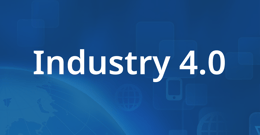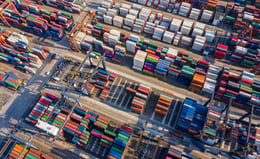Achieving Supply Chain Transparency Through Blockchain
Martin Pahulje - May 11, 2021

Transparency is a crucial feature of any successful supply chain. As every component of the supply chain network directly affects all others, it is vital that there be clear communication channels for all parts to work cohesively. In terms of the transfer of data, all channels and parts of the system need to receive the same information simultaneously. Many supply chain logistics companies have achieved a certain level of this transparency through the use of blockchain. Blockchain provides all parties within a respective supply chain with access to the same information through a chain of data sharing. Essentially, it is a technology that allows authenticated data communication between parties without the intermediation of a middle-man or trusted central organization.
This system is largely beneficial in reducing communication and transfer errors, which translates to less time spent validating data. As a result, there is more time to be spent on more vital practices such as delivering goods and services while improving quality and reducing cost. This is a highly advantageous supply chain management system, and that’s why so many companies utilize it – but it’s about to go one step further. New technological advancements in blockchain are presenting promising opportunities for optimization and improvement across the supply chain. Implementing blockchain in your supply chain has the potential to significantly increase transparency and traceability, in addition to reducing costs.
Why Blockchain?
The primary benefits of blockchain include improving the transparency and traceability of material throughout the supply chain network. Not only is this largely beneficial in terms of internal operations, but it is also very advantageous when working with external parties. In situations without a central agency of trust, blockchain can replace a traditional direct exchange of information. As we enter Industry 4.0, consumers are demanding more transparency in their  purchases, which increases the complexity of supply chains. To achieve this, every company needs an effective and inexpensive way to trace materials within the supply chain, ensuring the quality and timeliness of their final product. By verifying and adding data in real-time, blockchain provides this.
purchases, which increases the complexity of supply chains. To achieve this, every company needs an effective and inexpensive way to trace materials within the supply chain, ensuring the quality and timeliness of their final product. By verifying and adding data in real-time, blockchain provides this.
This is significant in building confidence with consumers and ensuring that materials are processed in an environmentally and socially conscious manner. In addition to transparency and traceability, blockchain can reduce administrative costs, lower the risk of fraud and gray market trading, and provide better control of outsourced manufacturing. We will walk through how blockchain will deliver each of these benefits to your organization, optimizing your supply chain and increasing visibility.
Advancements in Transparency & Visibility
Traceability and Transparency
A supply chain with blockchain can aid users in recording price, data, location, quality, and certification to manage their supply chain more effectively. Increasing the availability of this information through blockchain is instrumental to your operations, significantly boosting the traceability capabilities of your supply chain. With improved visibility and compliance over outsourced contract manufacturing, you will enhance your organization's position as a leader in manufacturing. With that being said, let's get into specifics. By digitally distributing a database of records, transactions, and events across a network of shared parties, blockchain can time stamp each transaction in the system, tracking and verifying all data. The data is stored in a chain of "blocks," compartmentalizing information while making it possible to access all blocks linked in the chain simultaneously. Essentially, it ties together data ensuring that it works cohesively and can be shared holistically. The blockchain database will retain the complete history of all assets.
The critical factor in this is the authenticity check that is run through all data in the blockchain. This system will check with users that their copy of the blockchain matches with all others, validating every transaction. The idea behind this is to discourage users from creating a blockchain with tampered data. This distributed verification method promotes both data integrity and transparency. Through this, parties do not need to know or trust one another in order to exchange valuable data –  they can share data in confidence that blockchain will verify all information. Additionally, blockchain does not have a central point of failure because all parties have a copy of the data, making it more durable than a traditional centralized system. Blockchain also has the ability to be programmed with embedded instructions to carry out actions when specific conditions are met. These can be used to program smart contracts which link the information in a blockchain to consequences when the agreed conditions are not met. This automation allows for increased control of the technology while not requiring constant manual monitoring.
they can share data in confidence that blockchain will verify all information. Additionally, blockchain does not have a central point of failure because all parties have a copy of the data, making it more durable than a traditional centralized system. Blockchain also has the ability to be programmed with embedded instructions to carry out actions when specific conditions are met. These can be used to program smart contracts which link the information in a blockchain to consequences when the agreed conditions are not met. This automation allows for increased control of the technology while not requiring constant manual monitoring.
Visibility
Tied in with traceability, blockchain’s ability to provide accurate end-to-end tracking is paramount in optimizing visibility. Through tracking data and materials as they move through your supply chain and blockchain, you can be certain of exactly how they are manufactured from start to finish. For organizations yearning to display social responsibility, this is an essential tool to promoting such features to the public. With blockchain, it is possible to digitize physical assets and create a decentralized record of all transactions. As a result, it is possible to track every asset from production to delivery and use by the end-user. This provides extreme visibility of the supply chain network while delivering greater product history and transparency. In terms of visibility, blockchain offers more for both businesses and consumers regarding the products they encounter. As was mentioned previously, this benefit even extends to the reduction of fraud, thus ensuring compliance. The likelihood of encountering counterfeit goods is higher for specific industries, and with blockchain, they can ensure authenticity, remaining reliable to consumers, and compliant with regulations. In understanding the history of the materials in each product, companies can reduce profit losses caused by counterfeit practices and legal disputes. Overall, this is a huge cost saver and will increase confidence for both your organization and end-users.
Bitcoin & Beyond
You are likely familiar with bitcoin, the earliest implementation of blockchain in the form of cryptocurrency. As it continues to rise with popularity, bitcoin has triggered widespread experimentation in blockchain. While primarily utilized in the financial industry, this trend has pushed both large corporations and startups to invent new uses for the technology in other industries, such as the supply chain logistics industry. As users continue to experiment with blockchain, more supply chain solutions are being developed to fulfill logistics needs. As experimentation and implementation continue, we will likely see the development of even more blockchain supply chain solutions. Only time will tell how much blockchain will grow in capabilities. By hopping on the trend now, you will not only optimize your supply chain visibility but prepare yourself for the promising future of blockchain. Blockchain will enable a more efficient supply chain, so it is important to pay attention as it gains momentum. Through streamlining operational and administrative processes, blockchain will significantly reduce costs within your organization. Ensuring the quality and status of your products and materials is essential for the success of a supply chain. With increased visibility and traceability, this and so much more will be achieved.
LATEST POSTS
- Understand Circular Economy in The Manufacturing Industry
- How Can Industry 4.0 IT Integration Be Achieved Smoothly?
- The Significance of Order Sequencing in Discrete Manufacturing
- How to improve your Supply Chain Management: The Power of Control Towers
- Optimizing Human Resource Scheduling in Manufacturing: A Technological Approach



